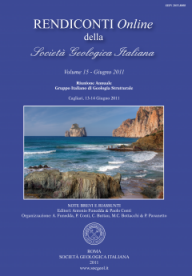
Structural and stratigraphic setting of the "Pseudoverrucano" in the Montebrandoli area, southern Tuscany
Antonio Baldetti (*), Gianluca Cornamusini (*,**) & Paolo Conti (*,**)
(*) Centro di Geotecnologie, Università di Siena, San Giovanni Valdarno (AR). E-mail: cornamusini@unisi.it
(**) Dipartimento di Scienze della Terra, Università di Siena, Siena.
DOI: https://doi.org/
Volume: 15/2011
Pages: 1-5
Abstract
A detailed geological field mapping and sampling has allowed to refine the stratigraphical and structural framework of the Montebrandoli area, which represent one of the few areas where the "Pseudoverrucano" lithofacies crops out. The "Pseudoverrucano", lying onto ?Paleozoic phyllites, consists in quartz conglomerates/breccias, reddish in colour, with sandstones and rare mudstones interlayers. They have been ascribed to an alluvial plain environment that gradually pass upward to the Montebrandoli Limestone, Rhetian-Hettangian in age, relative to a coastal marine/lagoonal environment. The Pseudoverrucano is also stratigraphically overlain by the "Scaglia", consisting of calcarenites and calcilutites, latest Cretaceous in age. Three stacked tectonic slices containing the Pseudoverrucano, here defined as subunits belonging to the Vacchereccia-Montebrandoli-Collelungo Unit, have been identified. They are tectonically overthrusted by Tuscan Nappe of the Poggio Moscona area. Based on field and regional data, we propose for the "Pseudoverrucano" succession a paleogeographic domain placed in the innermost part of the Tuscan Domain.
Keywords
Get Full Text